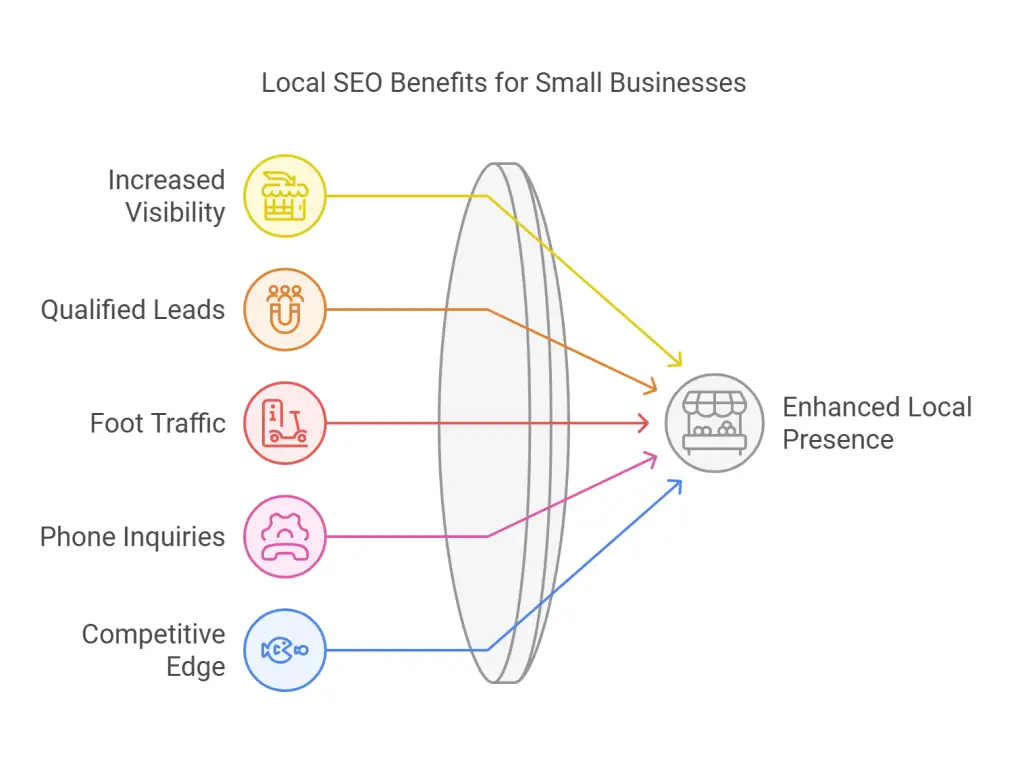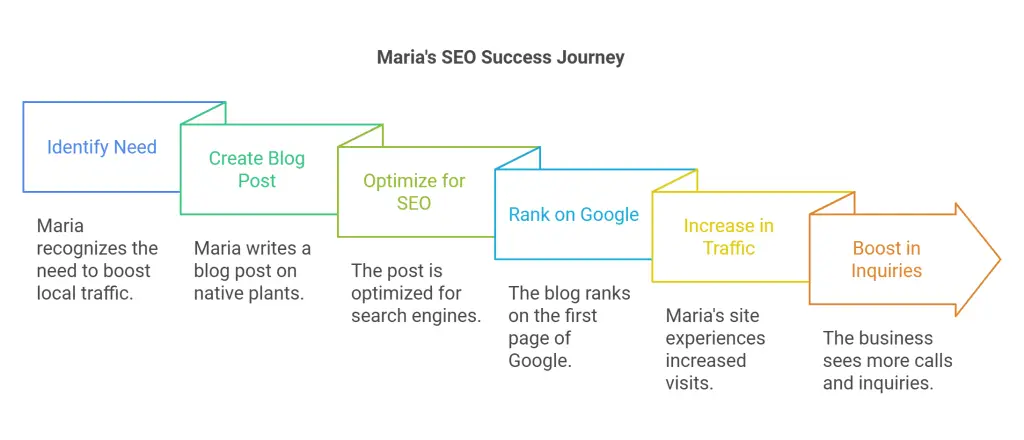Local businesses must adapt to the increasing importance of online visibility. Gone are the days when people would use phone books to find local services. Now, the majority of consumers turn to search engines like Google to locate nearby businesses. Whether you own a restaurant, plumbing service, retail shop, or law firm, your local online presence can make or break your business. Local SEO (Search Engine Optimization) is the key to ensuring that when customers search for services or products in your area, your business is the one they find.
Local SEO isn’t just about attracting clicks; it’s about attracting more physical foot traffic, phone calls, or service call inquiries from local customers actively looking for what you offer. This article will explore why local SEO is essential, how it works, and strategies you can use to grow your local visibility and bring more business through your doors.
The Importance of Local SEO for Small Businesses
What is Local SEO?
Local SEO is the process of optimizing your website and online presence to ensure your business appears in relevant local search results. These are search queries that include geographic-specific terms like “near me,” “in [city name],” or “local [product/service].” Local SEO differs from regular SEO by focusing specifically on searches performed within a specific location. It allows your business to stand out to potential customers within your service area, especially on mobile devices, which are increasingly being used for location-based searches.
Why is Local SEO for small businesses so crucial?
1. Increased Visibility in Search Results
Consider this scenario: A customer searching for a “plumber near me” is far more likely to call a service that shows up in the first few results than one buried deep in the search pages. Local SEO can significantly increase the chances that your business appears in these top results, especially in the Local Pack, which displays businesses with high relevance to the search query and location.
2. More Qualified Leads
The people who search for local services are often ready to make a purchase, book a service, or visit your store. Local SEO helps you target high-intent customers who are likely to convert, which means that the traffic generated through local SEO efforts is more valuable than random website visitors.
3. Drive Foot Traffic to Your Business
If you have a physical storefront, foot traffic is key. People searching for “coffee shop near me,” “restaurants in [city],” or “clothing stores in [neighborhood]” rely heavily on local search results to decide where to go. With local SEO, you can ensure that customers find your store first when they’re searching for what you offer nearby.
4. Increase Phone and Service Call Inquiries
Local searches are not limited to retail and hospitality. Service-based businesses like electricians, roofers, and dentists also benefit from local SEO because it helps drive phone calls and service bookings. Consumers looking for these services will call the businesses that appear first in search results, making a well-optimized local SEO strategy crucial for securing these leads.
5. Gain Competitive Edge
Local SEO levels the playing field for small and medium-sized businesses to compete with larger corporations. A well-executed local SEO strategy can help you rank higher than bigger companies for localized keywords, providing a competitive edge without the need for a massive marketing budget.

The Growing Impact of Mobile Search
The rise of smartphones has transformed the way consumers search for local businesses. According to Google, nearly 46% of all searches have a local intent, and many of those searches happen on mobile devices. Moreover, “near me” searches have grown exponentially over the past few years, meaning customers are increasingly looking for nearby options for the products or services they need.
When your business shows up in these mobile searches, the likelihood of a customer choosing your service or product increases significantly. Optimizing your website and online listings for mobile devices is a critical part of any local SEO strategy.
How Local SEO Works: Key Components and Ranking Factors
Understanding how local SEO works is essential to optimizing your website effectively. Several key ranking factors determine whether your business appears in local search results and how high you rank.
1. Google My Business (GMB) Optimization
Your Google My Business profile is a critical tool in local SEO. GMB listings are free to create and offer invaluable information to customers, such as your business name, address, phone number, hours of operation, website, and more. To rank well locally, your GMB profile must be complete, accurate, and updated regularly. Here are a few tips to optimize your GMB listing:
- Ensure your business name, address, and phone number (NAP) are consistent with what’s on your website and across all directories.
- Select the most relevant business categories.
- Add high-quality photos of your business, products, or services.
- Respond to customer reviews and engage with your audience.

Case Study: The Local Bakery Success
Lisa owns a small bakery in a busy downtown area. When she first opened, she struggled to attract foot traffic despite having a prime location. After optimizing her GMB profile with updated hours, beautiful photos of her baked goods, and consistently responding to reviews, Lisa saw a 30% increase in walk-in customers within six months. She also began appearing in the coveted Local Pack for searches like “best bakery near me.”

2. Localized Website Content
Your website needs to be optimized with localized keywords to attract local traffic. This means incorporating keywords that reference your city, neighborhood, or service area. It’s not enough to simply stuff your website with local keywords, however; the content needs to be valuable and relevant to your audience.
Create location-specific pages if you serve multiple areas. For example, a plumbing service could create individual pages for different towns they serve, each optimized with unique content that speaks to the needs of those local customers.
3. Online Reviews and Reputation Management
Customer reviews significantly impact local SEO rankings. Search engines favor businesses with a large number of positive reviews, and so do potential customers. According to a BrightLocal study, 87% of consumers read online reviews for local businesses, and 79% trust online reviews as much as personal recommendations. Here are some ways to get more reviews:
- Ask happy customers to leave a review after completing a service or purchase.
- Make it easy for customers to leave a review by providing direct links to your GMB or Yelp profiles.
- Respond to all reviews, both positive and negative, to show that you value customer feedback.

Case Study: The Auto Repair Shop That Boosted Service Calls
Jake’s Auto Repair was struggling to compete with national chains in his city. He started actively encouraging satisfied customers to leave reviews on Google. In less than a year, Jake’s Google rating jumped from 3.2 stars to 4.7 stars, and his monthly service calls increased by 40%. The positive reviews not only improved his local SEO rankings but also built trust with potential customers.

4. Local Citations and NAP Consistency
Local citations are online mentions of your business name, address, and phone number (NAP) across various websites, such as directories, social media, and review platforms. Ensuring that your NAP information is consistent across all these listings is essential for local SEO.
Some common places to create citations include:
- Yelp
- Local Chamber of Commerce websites
- Yellow Pages
- Industry-specific directories (e.g., Avvo for lawyers)
Search engines use citations as a trust signal, so the more reputable websites that mention your business, the better it will rank.
5. Mobile Optimization
With so many searches happening on mobile devices, ensuring your website is mobile-friendly is critical. Google prioritizes mobile-first indexing, which means it ranks websites based on their mobile version first. If your site isn’t optimized for mobile, you’re likely losing out on local traffic and hurting your rankings.
Mobile optimization involves ensuring fast load times, a user-friendly design, and easy navigation. Make sure your contact information is easy to find and clickable, so potential customers can call you directly from their mobile devices.
6. Schema Markup for Local Businesses
Schema markup is a form of microdata that helps search engines better understand the content on your website. For local businesses, adding structured data markup to your site can help it appear in rich snippets on search results pages. This can include things like:
- Business hours
- Contact information
- Reviews and ratings
- Location
Adding local schema markup ensures that your business information is accurately displayed and increases the chances of appearing in local search features like the Local Pack or knowledge panels.

Actionable Strategies to Improve Your Local SEO
Now that we’ve covered why local SEO for small businesses is important and how it works, let’s dive into actionable strategies you can implement to improve your local visibility.
1. Claim and Optimize Your Google My Business Profile
The first and most critical step is to claim your GMB profile and fully optimize it. Ensure all your business information is accurate and updated. Add relevant categories, post regularly (such as promoting sales or events), and engage with reviews.
2. Create Locally Optimized Content
Regularly update your website with blog posts or articles relevant to your local community. This could include industry news, local events, or tips specific to your location. You can also create content targeting specific geographic areas, such as guides, “top 10 lists,” or service-specific blog posts that include your city or neighborhood.

Case Study: Efficiently Using SEO for Small Business via Blog Posting to Skyrocket Maria’s Local Traffic
Maria owns a landscaping company and wanted to increase local traffic to her site. She wrote a blog post titled “Top 10 Native Plants for Landscaping in [City],” which included advice tailored to her local climate and soil conditions. The post quickly ranked on the first page of Google for local landscaping searches, and within a few months, her business saw a notable increase in calls and inquiries, proving the value of SEO for small businesses.

3. Encourage Customer Reviews
Make asking for reviews part of your business process. For example, after a job or sale is completed, you can send an email thanking the customer and asking them to leave a review on Google or another platform. Incentivizing reviews through small discounts or loyalty points can also encourage more people to leave feedback.
4. Build Local Backlinks
Backlinks, or links from other reputable websites to yours, are a major factor in SEO rankings. Building local backlinks from community websites, local blogs, news outlets, or other trusted local sources can improve your local SEO. Consider sponsoring local events, collaborating with local influencers, or submitting press releases to local media outlets to generate backlinks.
5. Use Location Pages for Multi-Location Businesses
If your business operates in multiple locations, create individual pages for each service area. Each page should include unique content relevant to that location, such as different services, customer testimonials from that area, or special promotions.
6. Optimize for Voice Search
With the rise of voice search assistants like Alexa, Siri, and Google Assistant, optimizing your website for voice search can give you an edge. Voice search queries are often more conversational, so incorporating long-tail keywords and natural language into your content can help your business rank for these types of searches.
7. Monitor and Analyze Local SEO Performance
Lastly, make sure you’re tracking your local SEO performance. Tools like Google Analytics and Google Search Console provide valuable insights into how your website is performing in local search results. Monitor key metrics like organic traffic, keyword rankings, and user engagement to identify areas for improvement.
Potential Challenges and Solutions in Local SEO
While the benefits of local SEO are clear, there are some challenges that businesses may face when trying to optimize their presence with SEO for small business strategies.
Adapting to Algorithm Changes
Search engine algorithms are constantly evolving, which means that your local SEO strategy must evolve too. Stay informed about changes in local SEO best practices by reading industry blogs, attending webinars, and networking with other business owners or marketers. A flexible SEO for small business approach will help you adapt to these changes, ensuring continued visibility and success in local search rankings.
Fierce Local Competition
In densely populated areas, competition for local search rankings can be tough. Larger companies with bigger budgets might have an advantage, but this doesn’t mean smaller businesses can’t compete using effective SEO for small business techniques. Focus on providing outstanding customer service, encouraging reviews, and creating high-quality, locally relevant content to carve out your niche. Utilizing SEO for small business tactics helps level the playing field against larger competitors.
Maintaining NAP Consistency
If you’ve listed your business in many directories, it can be challenging to keep all NAP information consistent. A good solution is to use tools like Moz Local or Yext to manage and monitor your local citations automatically. Consistent NAP details are crucial components of an SEO for small business approach, ensuring that search engines trust your business information.
Dealing with Negative Reviews
No business is immune to receiving negative reviews, but how you handle them can make a huge difference. Respond politely and professionally, address the customer’s concerns, and show a willingness to correct any issues. In many cases, customers will appreciate your responsiveness and may update their reviews. This responsiveness is a key element of a well-rounded SEO for small business strategy, as positive reviews boost local reputation.

Conclusion
Local SEO is no longer a luxury for small businesses—it’s a necessity. By optimizing your website and online presence for local search using SEO for small business strategies, you increase your chances of attracting foot traffic, phone calls, and service inquiries from people actively looking for the products or services you offer. Whether it’s through Google My Business optimization, online reviews, local content creation, or mobile optimization, local SEO is a powerful tool for any business looking to grow its local presence.
By following the strategies outlined in this article, you can create a robust local SEO strategy that not only boosts your rankings but also drives more traffic and leads to your business. Start implementing these tips today, and watch your local visibility and customer base grow through effective SEO for small business techniques.
Frequently Asked Questions
How does Local SEO benefit small businesses?
Local SEO enhances a business’s visibility in geographically relevant searches, attracting nearby customers. This leads to increased foot traffic, phone inquiries, and service bookings from individuals actively seeking local products or services.
Why is optimizing Google My Business (GMB) crucial for small businesses?
A well-optimized GMB profile boosts local search rankings by providing accurate business information, photos, and customer reviews. This enhances credibility and ensures potential customers find trustworthy details about your business.
How do customer reviews influence a small business’s local SEO?
Positive customer reviews build trust and signal to search engines that your business is reputable. Encouraging satisfied clients to leave reviews and responding promptly to feedback can improve your local search rankings and attract more customers.
What role does mobile optimization play in attracting local customers?
With a significant number of local searches conducted on mobile devices, ensuring your website is mobile-friendly is crucial. A responsive design and fast load times enhance user experience, leading to higher engagement and better local search rankings.
Why is consistent NAP (Name, Address, Phone Number) information important for small businesses?
Consistency in your business’s NAP across all online platforms ensures search engines and customers have accurate information. Inconsistent details can confuse users and negatively impact your local search rankings.
Further reading
Enge, Eric, Stephan Spencer, and Jessie Stricchiola. The Art of SEO: Mastering Search Engine Optimization. 3rd ed. Sebastopol, CA: O’Reilly Media, 2015. https://www.amazon.com/Art-SEO-Mastering-Search-Optimization/dp/1491948965/
Clarke, Adam. SEO 2021: Learn Search Engine Optimization with Smart Internet Marketing Strategies. CreateSpace Independent Publishing Platform, 2021. https://www.amazon.com/SEO-2021-Learn-Search-Optimization/dp/1913587249/
Fishkin, Rand. Lost and Founder: A Painfully Honest Field Guide to the Startup World. Portfolio, 2018. https://www.amazon.com/Lost-Founder-Painfully-Honest-Startup/dp/0735213654/
Dean, Brian. “SEO for Small Business: 10 Strategies to Grow Your Business Online.” Backlinko. Last modified October 2023. https://backlinko.com/seo-for-small-business
Patel, Neil. “SEO for Small Business: A Complete Guide to Getting Found.” Neil Patel Blog. Accessed January 8, 2025. https://neilpatel.com/blog/seo-small-business/
Haden, Jeff. “How to Use SEO to Grow Your Small Business.” Inc.com. Last modified September 15, 2022. https://www.inc.com/jeff-haden/use-seo-to-grow-small-business.html
Moz. “The Beginner’s Guide to SEO.” Moz. Accessed January 8, 2025. https://moz.com/beginners-guide-to-seo
HubSpot. “How to Use SEO for Small Business: A Beginners’ Guide.” HubSpot Blog. Last modified November 2023. https://blog.hubspot.com/marketing/seo-for-small-business
Search Engine Journal. “SEO Tips for Small Business: How to Optimize Your Website for Local Searches.” Search Engine Journal, January 2024. https://www.searchenginejournal.com/seo-tips-small-business/







